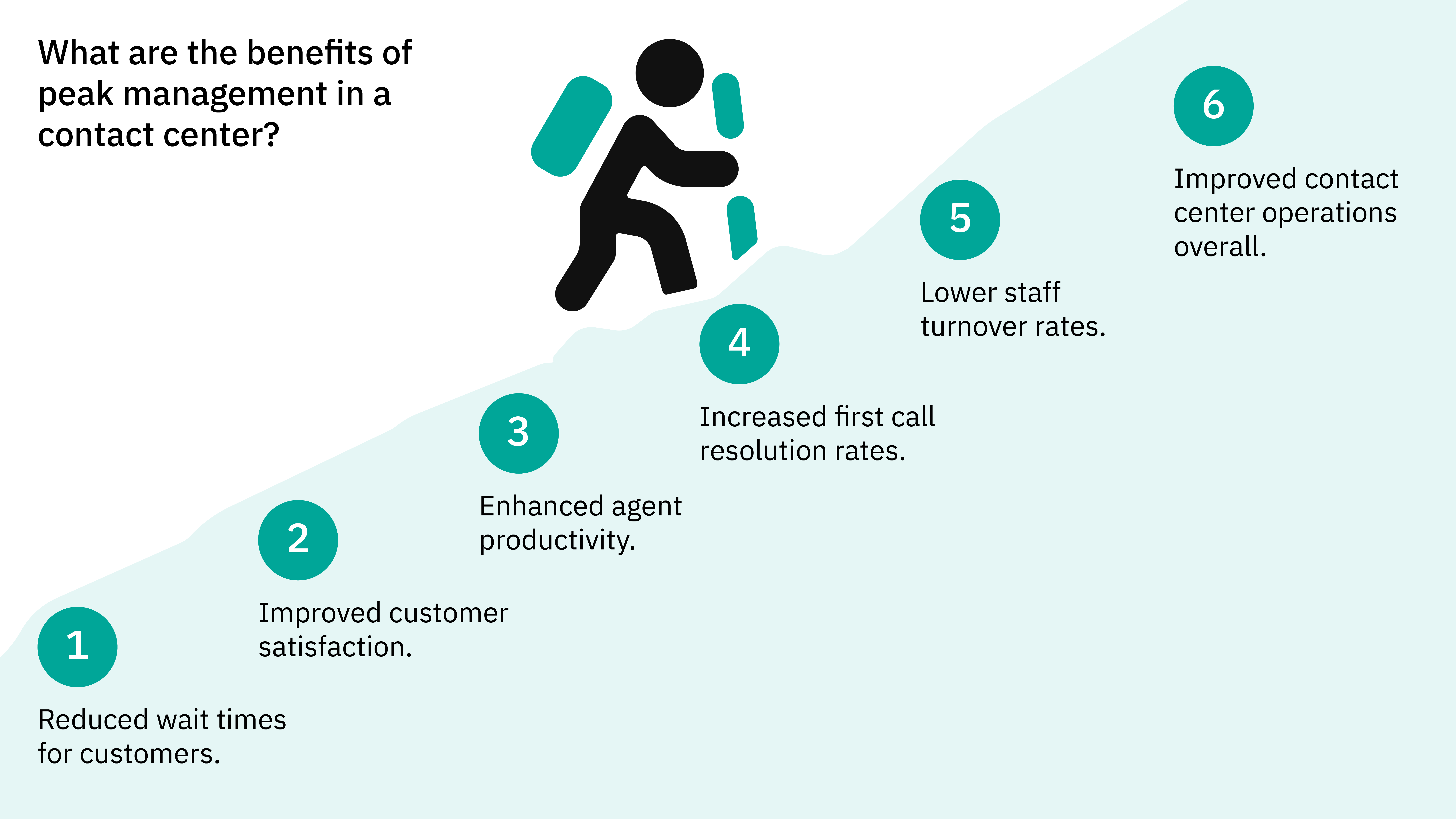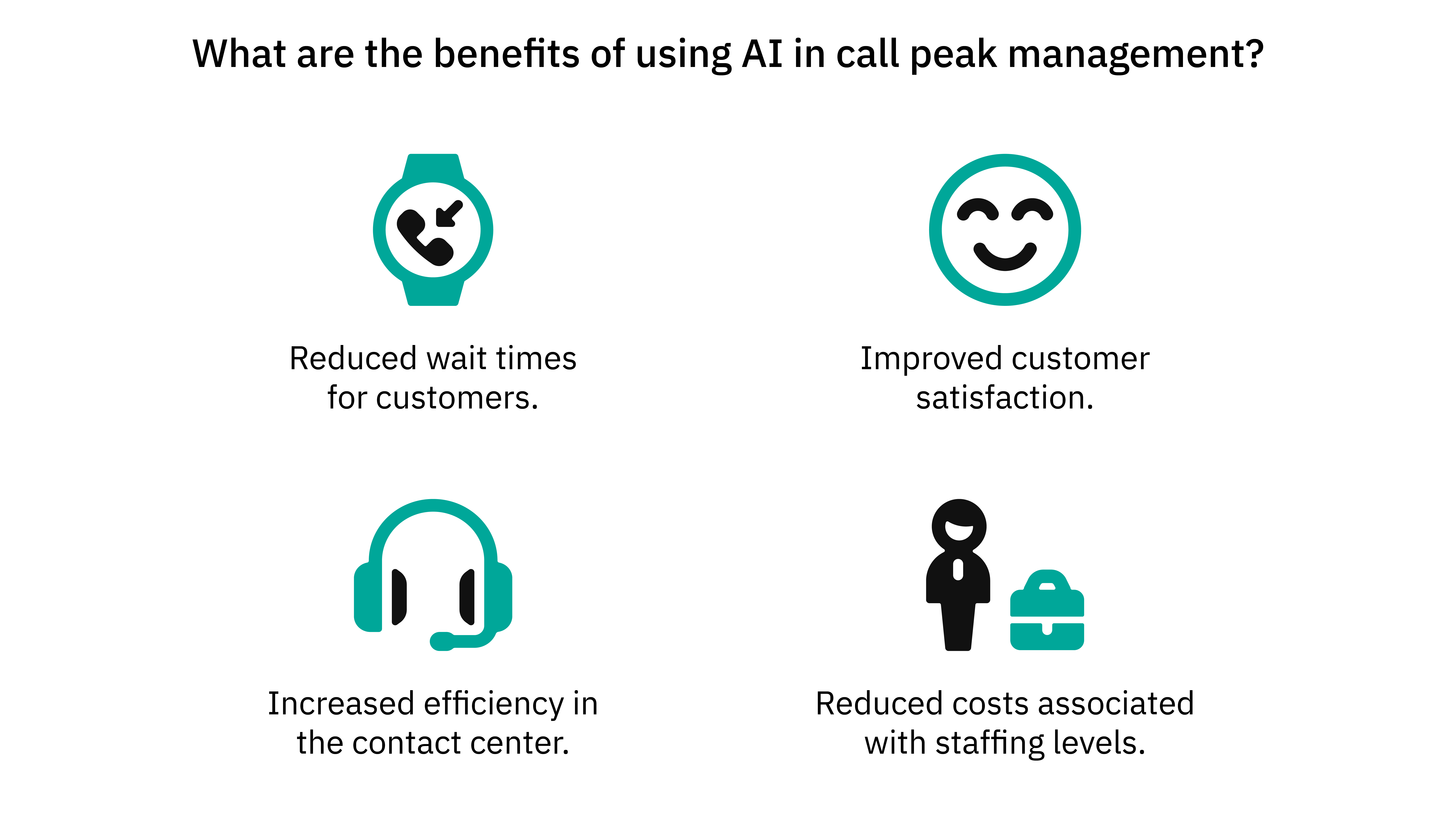g aaa fff
The fundamentals of peak management in a contact center.
What is peak management in a contact center?
Call peak is the time of day, or days of the week, when the number of inbound calls or messages to a contact center are at their highest. This can be a result of a variety of factors, such as the nature of the business, or new product or service release. These can be anticipated based on historical data. For example, many businesses see a spike in calls on Monday mornings as customers try to resolve issues.
Call peaks also happen at particular times throughout the year, such as holidays (think Christmas, Easter, etc.) or more intensive sale seasons, such as Black Friday or Cyber Monday. We call these planned peaks, as they tend to affect businesses in the same period each year. As an example, Christmas is one of the busiest times of the year for contact centers. This is due to the increase in online shopping and the resulting customer enquiries and complaints.
The repetitive nature of these peaks means that it’s possible to anticipate and plan for them in advance. We call this forecasting, and we’ll come back to it later in this article. But what about when a peak is unplanned?
Here are some of the causes of unplanned peaks:
- Technical problems. Technical problems, such as website outages or phone line issues, can lead to an increase in customer calls.
- Product or service issues. Recalls of a product or issues with a service such as an app can result in higher contact volumes.
- New marketing campaigns. Releasing a new product, rebranding, or announcing new services can lead to an increased interest from customers, making them more likely to reach out to customer support.
- National crises. Natural disasters, such as floods or hurricanes, socio-political changes, or epidemics, can lead to an increase in customer calls.
As you can see, peaks of any nature, planned or unplanned, can hit at any moment. The question then becomes - how do they impact your business, and how can you best prepare?

How can peak periods affect your business?
One of the biggest issues associated with peak management is of course customer frustration and the resulting negative perception of your brand. However, this is just one of the potential consequences of not preparing adequately for increased inbound call volumes.
Some of the most common issues resulting from poor peak management are:
- Missed calls: When customers are unable to get through to the contact center, they may hang up and try again later, resulting in a missed call. This limits your ability to connect with your customer base and resolve their issues.
- Abandoned calls: If customers are on hold for too long, they may eventually hang up, resulting in an abandoned call. Over 60% of customers reported that if they are left on hold for just a minute, they will hang up.
- Customer frustration: Long wait times and dropped calls can lead to customer frustration, which results in a negative experience and lower customer satisfaction rates.
- Reduced productivity: When agents are constantly dealing with long hold-times and abandoned calls, their productivity suffers. This can ultimately lead to a lower eNPS and issues with staffing and retention.
There should be no question of why this makes peak management such a crucial topic. Customer expectations are at higher levels than ever, which means that brands need to find a way to manage them and even exceed them. By being aware of the impact of peaks on your business, preparing for them in advance, and constantly seeking to improve, you can ensure that customers stay happy and loyal to your brand.
What are the benefits of peak management in a contact center?
- Reduced wait times for customers.
- Improved customer satisfaction.
- Enhanced agent productivity.
- Increased first call resolution rates.
- Lower staff turnover rates.
- Improved contact center operations overall.
How can you prepare for planned peaks?
First and foremost, the best ways to combat the challenges associated with call volume peaks are preparation and expertise. With a trusted and experienced CX partner, you can outsource the task of gathering and analyzing data from previous periods, implementing innovative technology to aid in customer support, and ensure the best hiring and training processes for your workforce.
It’s important to keep in mind that your business may encounter challenges that are specific to your industry, location, or customer base. With the right data and insights on your side, you can be prepared for even the most difficult scenarios, and ensure that your customers stay satisfied. At the end of the day, it all boils down to a few things: planning, people, and technology.
Plan for the worst, expect the best.
-
Content may be king, but data is queen.
We mentioned forecasting earlier - which is essentially planning out periods of peaks during the year. It can seem daunting to try and anticipate all the times when a peak might happen. Consider seasonal and holiday peaks that affect other companies in your industry. Make a note of planned product or service launches and expect higher call volumes in that time. Use past data to gauge the busiest times for your business’ customer support. -
Use intelligent tools to help you plan.
Don’t limit yourself to a notepad or a complicated spreadsheet! Thanks to tools like Transcom Reporting Experience, you can see real-time data on call volumes, wait times, resolution times, and agent workload - all data that you can include in your quarterly or yearly plans. -
Communicate with your teams.
Planning for peaks is a team sport. Ensure that all stakeholders in your company are aware of the peak schedule so they can act accordingly. Sales, HR, Recruitment, Marketing, and all other relevant departments are your support in making sure operations run smoothly even during times of increased demand.
The people make a place.
-
Hire the right people.
Hiring more staff during peak season can be an obvious and effective way to reduce the impact on your business, but it can also be the most expensive. Try to find experienced team members that can handle the increased workload like pros. -
No train, no gain.
Without proper training and development, even the best agents may struggle during peak season. Make sure that you provide them with the highest quality training and continuously refine the process to improve it. Transcom prides itself on relentlessly working to develop our people, so they can serve your customers better. -
Take care of your people.
Scheduling breaks for agents during busy periods can help to reduce frustration and improve morale. Use incentives such as bonus pay to motivate them, implement wellbeing initiatives to combat rising stress levels, and above all, keep them informed about what’s going on and your plan to handle peaks.

Use tech to your advantage.
-
Let’s befriend the bots.
Chatbots and voice bots can be incredible tools in managing high call volumes. Chatbots and IVR technology can deflect calls by answering simple customer queries, thereby reducing the pressure on your agents and allowing them to spend more time on more complex requests. -
Automate with call back services and ACD.
Automation is the best life hack! Automated call distribution (ACD) systems use AI to route calls more efficiently, based on factors such as the customer’s location or the nature of their query. Call back services reduce wait times for customers by calling them back when an agent is available. -
Predictive analytics.
AI can be used to predict when call volumes are likely to peak, and help contact centers to plan accordingly.
It’s clear that there’s a multitude of ways in which you can prepare for peaks both planned and unplanned. Thanks to these fundamentals, you can rest easy knowing your business is prepared for an eventuality.
Keeping your customers happy and loyal.
If you think peaks are an inconvenience and challenge for you and your business, imagine how your customers must feel! Whether they’ve ordered the wrong size jacket to wear to Thanksgiving dinner, or their dishwasher has broken just before Christmas dinner, their needs are our top priority. Especially in a time of increased stress and demand. How can you make sure that your customers aren’t caught off guard during peak call times? With the proper preparation, effective communication, and regular feedback.
Automated messages.
Using automated messages to keep your customers informed during peak season can be highly effective. When they call for support, you can let them know of expected wait times to help manage their expectations, and keep them up to date on any changes that occur. If they know what’s going on with your customer support, they’re less likely to feel frustrated at having to wait an extra minute or two.
Social media and other channels.
One of the most powerful tools of our time, social media is a great way to connect with your customer base in general. During times of increased peaks, you can post updates to your channels which will reach a wider audience and act as real-time status reports on when they can expect support.
“How would you rate our service today?”
Surveying your customers is one of the most fundamental parts of improving your operations and keeping them loyal to your brand. With their feedback, you can identify areas for improvement, and take action to adjust your operations as needed. Certain tools such as AI or business intelligence dashboards can help you get the most out of this data, such as our Transcom Reporting Experience.
As mentioned earlier, your business is built on the loyalty of customers, and that loyalty is conditional on several factors: the highest quality of products and services, positive brand reputation, and stellar customer experience. Make sure that their satisfaction is your priority.
Using data to improve peak management.
We’ve spoken about forecasting and how to use data and technology as a key part of peak management. The importance of data can’t be understated. It’s the bedrock for all of your operations, whether you’re thinking about agent training, anticipating high call volumes, or optimization in general.
The best tools for data analytics do the job of both gathering and helping you to analyze the data to get insights. The Transcom Reporting Experience provides exactly that, as a highly sophisticated business intelligence suite, accessible from anywhere (including mobile) and displaying real-time data, which enables you to make decisions quickly and confidently.
What are the best ways to use data to improve contact center operations?
- Determining staffing needs. Data can be used to identify times when the contact center is typically busiest and help you to recruit employees accordingly.
- Analyzing call patterns. By analyzing call patterns, contact centers can identify trends and make necessary changes, such as adjusting the IVR menu or engaging other centers in your network.
- Evaluating customer satisfaction. Regular surveys can help to evaluate customer satisfaction and pinpoint areas that need improvement.
- Measuring agent performance. Data can be used to measure agent performance and identify areas where additional training may be needed, such as product knowledge.
- Optimizing the contact center. By analyzing data, contact centers can identify inefficiencies and make changes to optimize operations.